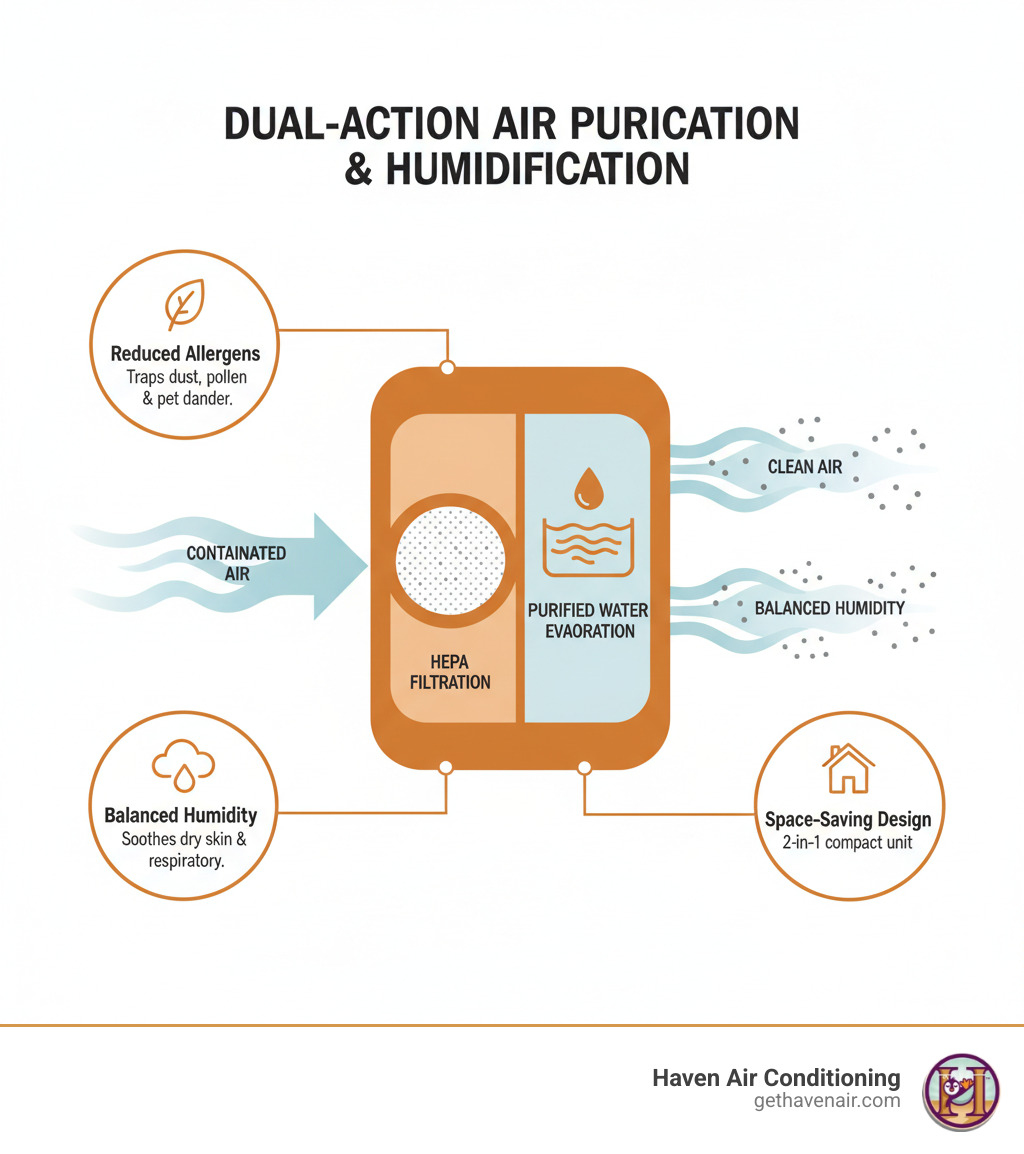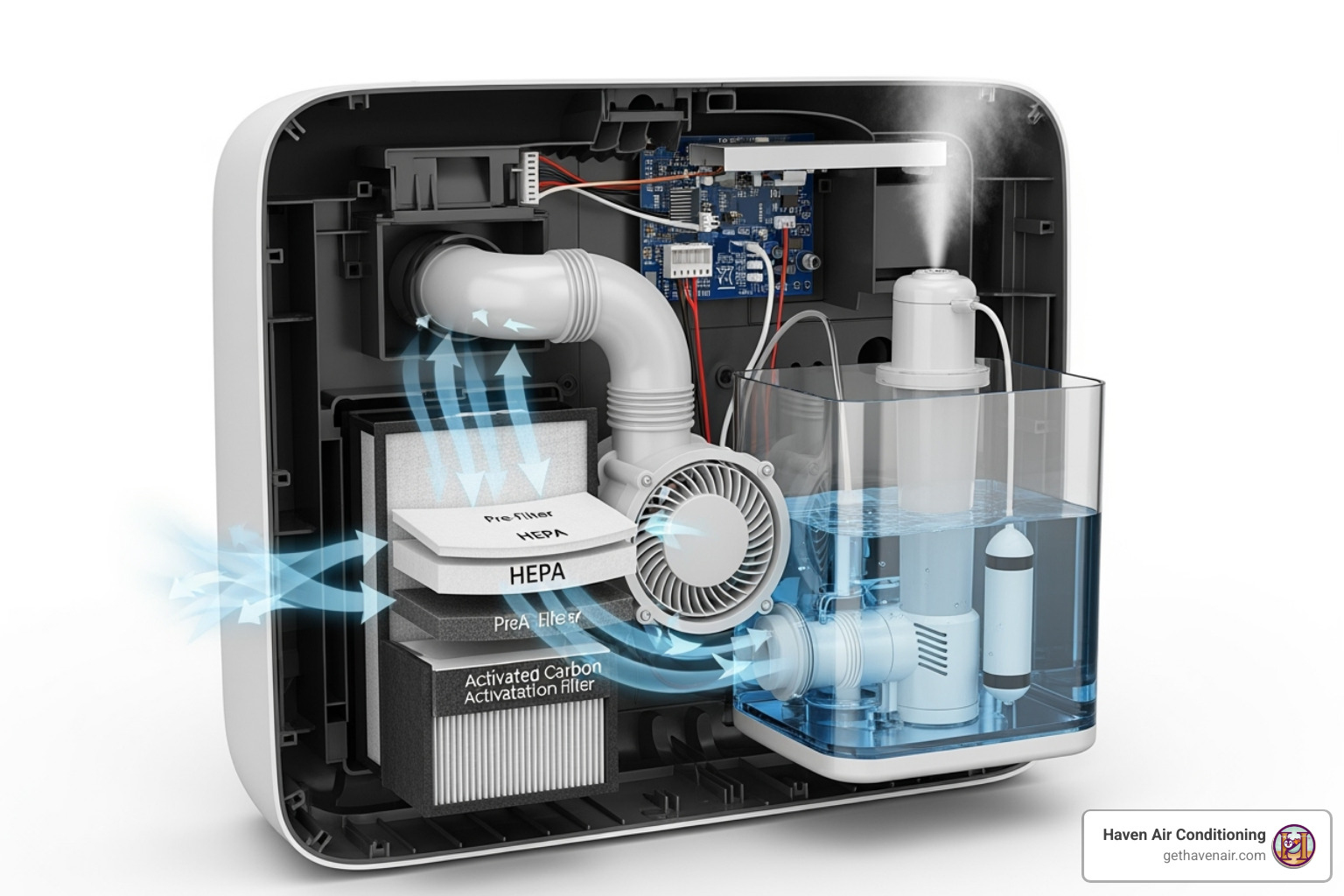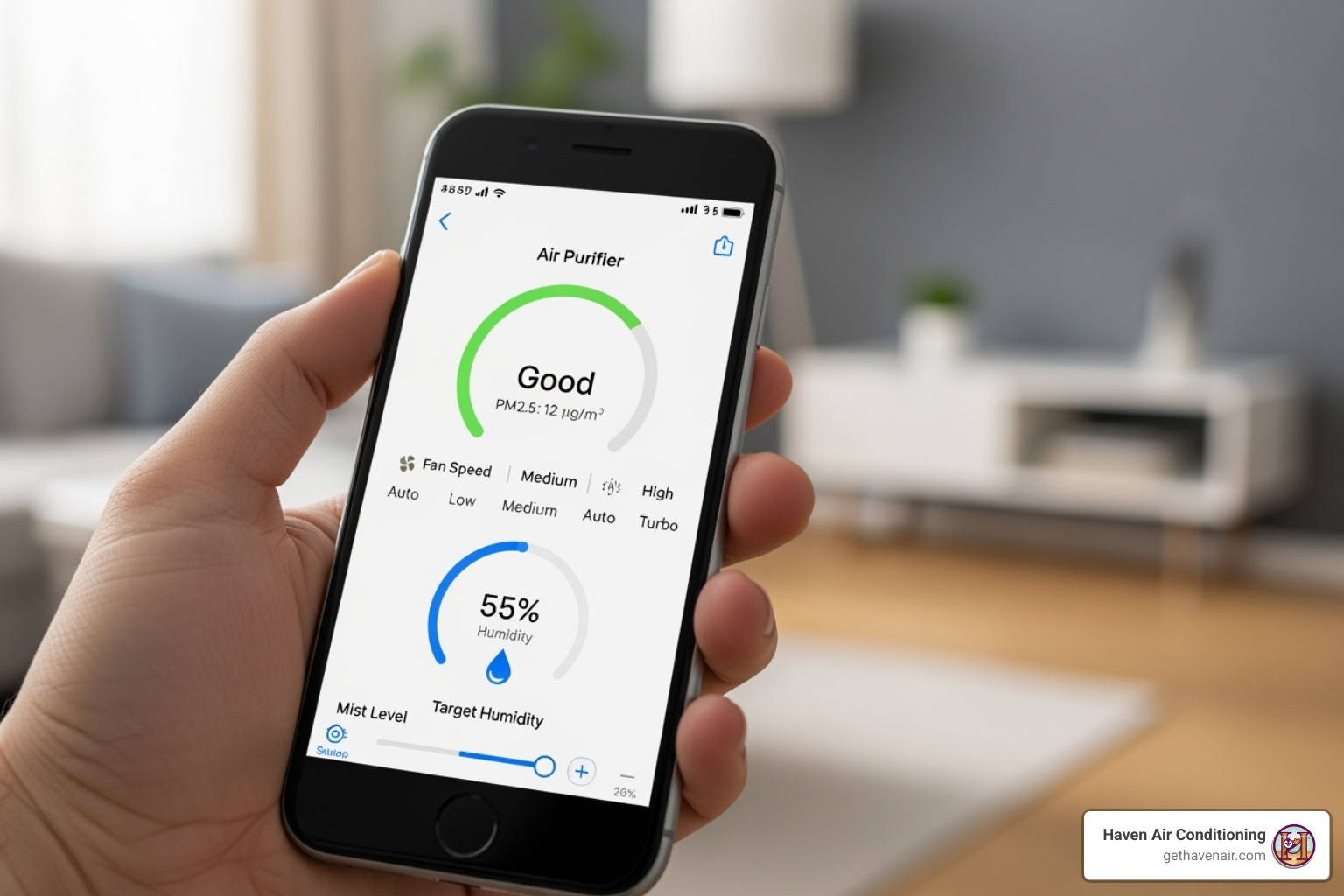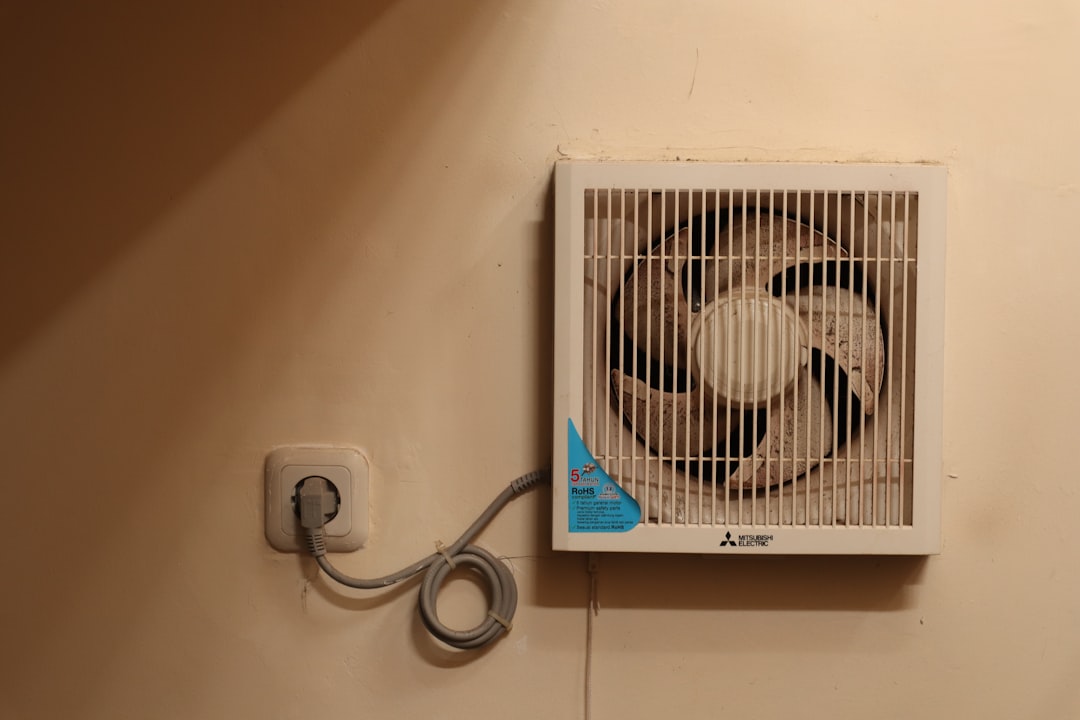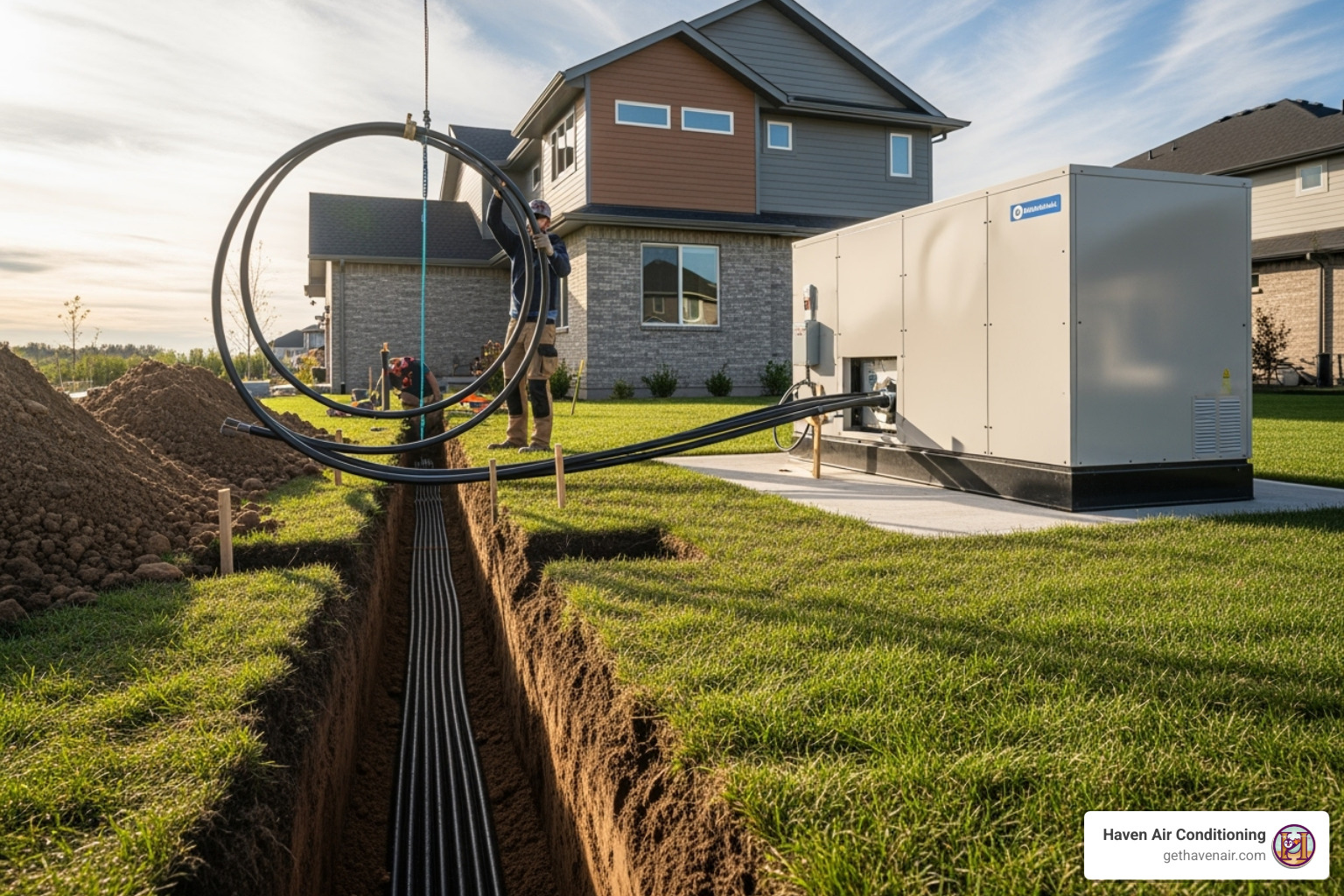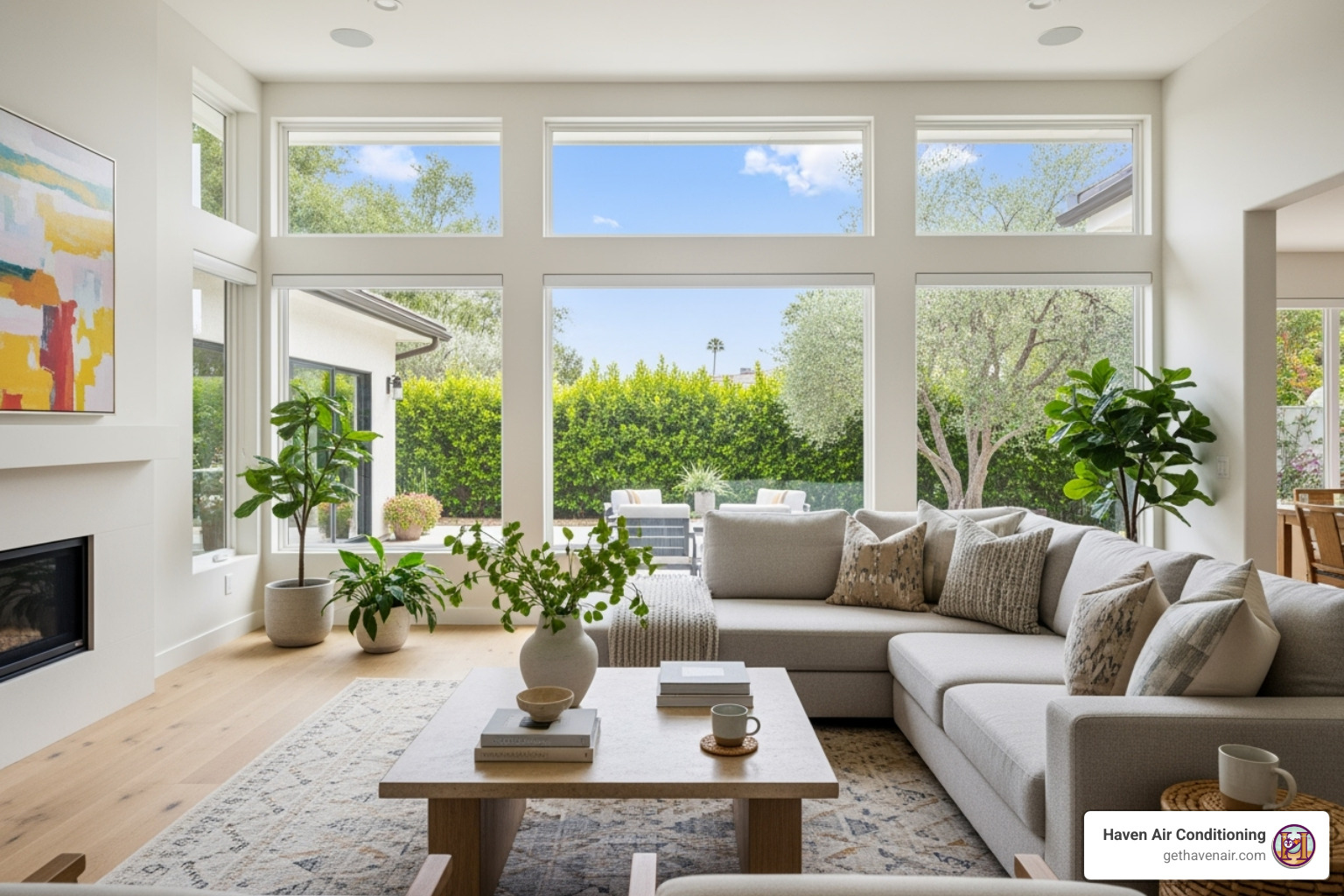Why Clean Air and Balanced Humidity Matter in Your Home
An air purifier with humidity control combines two essential functions in one device: removing airborne pollutants while maintaining optimal moisture levels in your indoor air. These 2-in-1 units trap dust, allergens, and pet dander while preventing the dry air that often accompanies air purification, especially during Orange County’s cooler months when heating systems run frequently.
Many homeowners struggle with poor air quality and uncomfortable dryness. While air purifiers remove pollutants, their airflow can make rooms feel drier. Adding a separate humidifier means finding more space and managing two appliances. A combination unit solves both problems efficiently.
For expert guidance on comprehensive indoor comfort solutions, check out our Indoor Air Quality services, or contact Haven Air Conditioning to discuss your specific needs.
The Science of Synergy: How Purifier-Humidifier Combos Work
An air purifier with humidity control solves two problems at once: it cleans your air and adds necessary moisture. These devices are especially useful during cooler Orange County months when heating systems create dry indoor conditions. Inside, two systems work in tandem. The purification side filters out pollutants, while the humidification side releases clean moisture, resulting in air that is both clean and comfortable.
For a deeper look at creating the ideal indoor environment, check out our comprehensive guide on Indoor Air Quality.
How Air is Cleaned
The purification side uses a multi-stage approach to trap contaminants.
- Pre-filters catch large particles like hair and lint, protecting the more delicate inner filters.
- True HEPA filters are the core of the system, capturing 99.97% of particles as small as 0.3 microns, including pollen, pet dander, and mold spores.
- Activated carbon filters absorb odors and volatile organic compounds (VOCs) from cleaning products, cooking, and furniture.
Some units offer advanced features like UV-C light to inactivate bacteria and viruses or specialized technology like Sharp’s Plasmacluster® Ion Technology to balance air ions.
How Humidity is Added
Air purifiers do not remove humidity because water molecules are too small to be caught by their filters. Water molecules measure around 0.275 nanometers, while HEPA filters target particles of 0.3 microns (300 nanometers) and larger.
Combo units add moisture using evaporative or ultrasonic technology. Most use evaporative humidification, where water from a reservoir (the water tank) is drawn through a wick filter and evaporates naturally into the air. This process releases cool, invisible moisture without leaving white mineral dust on furniture. Technologies like cool mist help relieve dry skin and reduce static electricity, creating a more comfortable indoor environment.
Key Features of an Air Purifier with Humidity Control
When shopping for an air purifier with humidity control, focus on features that match your space and lifestyle. The best units blend powerful air cleaning with effective moisture control, all while being easy to live with.
Filtration Technology and Performance
The filtration system is crucial for air quality. Look for:
- True HEPA filters: The H13 standard is ideal, capturing 99.97% of airborne particles like PM2.5, allergens, dust, and pet dander.
- Activated carbon filters: These tackle odors, smoke, and volatile organic compounds (VOCs). Some advanced models even target specific chemicals like formaldehyde.
- Advanced technologies: Some units include UV-C LED technology to inactivate bacteria and viruses or ion-balancing features like Sharp’s Plasmacluster® Ion Technology to refresh the air.
Humidification Capacity and Control
Proper humidity levels are key to comfort. Consider:
- Water tank size: Larger tanks mean less frequent refills, which is convenient for overnight use.
- Humidification rate: Measured in ml per hour, this tells you how quickly the unit adds moisture to the air, affecting its suitability for your room size.
- Auto-humidify settings: Built-in sensors monitor and automatically adjust humidity to optimal levels (typically 40-60%), offering set-it-and-forget-it convenience.
- Humidification method: Most combos use cool mist or evaporative technology, which avoids the “white dust” of mineral deposits common with some ultrasonic models.
Room Size, Power, and Noise
Practical details determine how well the unit fits into your home:
- Coverage area: Match the unit’s recommended square footage to your room size. Some units handle small rooms, while others can cover large, open-concept areas.
- CADR and ACH: The Clean Air Delivery Rate (CADR) measures cleaning speed. Air Changes Per Hour (ACH) tells you how often the room’s air is filtered. Aim for at least 4 ACH for allergy or asthma relief.
- Noise levels: Look for units with low decibel (dB) ratings, especially for bedrooms. Many models offer a quiet sleep mode (as low as 22 dB).
- Energy efficiency: An ENERGY STAR certified model will be more efficient, saving money on utility bills. A single combo unit is often more energy-efficient than running two separate appliances.
The Pros and Cons of a 2-in-1 Unit
Choosing between an air purifier with humidity control and two separate devices involves weighing convenience against specialization. There’s no single right answer—just the best fit for your home and needs.
| Feature | Combo Unit (2-in-1) | Separate Units (Air Purifier + Humidifier) |
|---|---|---|
| Space Saving | Takes up less floor space, ideal for smaller homes or apartments. ORB 2 in 1 is only 7.7 inches in diameter. | Requires space for two distinct appliances, can clutter rooms. |
| Convenience | Single power cord, one set of controls, often integrated smart features. | Two power cords, two control panels, separate maintenance schedules. |
| Maintenance | Consolidated filter/water tank changes, but can be more complex if components are intertwined. | Separate maintenance for each, potentially simpler for each individual task. |
| Performance | Good overall performance, but might not match the top-tier capabilities of specialized units. | Each unit can be chosen for peak performance in its specific function. |
| Cost | Often a more economical initial purchase than two high-quality separate units. | Potentially higher initial investment for two high-performance units. |
| Flexibility | Less flexible; if one function isn’t needed, the other might still operate. | High flexibility; use only the air purifier or only the humidifier as needed. |
| Reliability | Single point of failure; if one component breaks, the whole unit may be unusable. | If one unit breaks, the other can still function independently. |
| Aesthetics | Streamlined, modern design. | Can be less cohesive visually, depending on individual unit designs. |
Advantages of an Integrated System
The primary benefits of a combo unit are space-saving design and convenience. With one appliance, you have a smaller footprint, a single power cord, and one maintenance schedule. This minimalist approach is perfect for smaller Orange County homes and apartments, similar to the philosophy behind Space-Saving Ductless AC in Modern Homes.
These units also offer synchronized operation, using sensors to automatically balance air quality and humidity. Many are also more energy-efficient than running two separate appliances, which is good for your wallet and the environment.
Potential Drawbacks to Consider
On the other hand, there are a few trade-offs. Maintenance can be slightly more complex since the components are intertwined. There’s also a single point of failure; if one part breaks, you may lose both functions.
While performance is excellent for most households, a combo unit might not match the absolute peak power of a top-of-the-line dedicated purifier or humidifier. Finally, some models require the purifier to be running for the humidifier to work, reducing flexibility. For most users, however, the convenience and streamlined design of an air purifier with humidity control outweigh these potential downsides.
Maintenance: Keeping Your Combo Unit in Top Shape
Regular maintenance for your air purifier with humidity control is essential for it to deliver clean, properly humidified air. Neglecting it can compromise performance and air quality, which is the last thing Orange County homeowners want from their comfort systems.
Routine Cleaning for a Healthy Home
The humidification component requires the most attention to prevent bacteria and mold growth in stagnant water.
- Weekly Tank Cleaning: Empty the water tank, scrub it with a soft brush and mild detergent or a vinegar-water solution, and rinse thoroughly before refilling.
- Descaling: To combat mineral buildup from hard water, regularly descale components according to the manufacturer’s instructions. Soaking parts in a citric acid solution is often effective.
- Wipe Down: Regularly wipe down the unit’s exterior, vents, and sensors with a damp cloth to remove dust that can interfere with readings.
- Ensure Airflow: Keep the unit away from walls and furniture to allow for proper air circulation. Unusual noises could be a sign it needs attention, similar to the Warning Signs a Ductless AC Needs Attention.
Filter and Wick Replacement for an air purifier with humidity control
Filters become saturated over time and must be replaced to maintain performance.
- Filter Life Indicators: Most modern units have an indicator light or app notification to tell you when it’s time for a change. Some apps even calculate filter life based on usage.
- Replacement Schedule: Air purifier filters typically last six to twelve months, though this varies by model and air quality. Humidifier wick filters usually need replacement every six months as they accumulate minerals.
- Use Genuine Parts: Always use manufacturer-approved filters and wicks. Generic alternatives may not fit correctly, can offer inferior performance, and could void your warranty. It’s a small investment in your unit’s longevity and your home’s air quality. For more guidance, explore our Indoor Air Quality services.
Frequently Asked Questions about Air Purifier and Humidifier Combos
Here are answers to common questions our Orange County customers have when considering an air purifier with humidity control.
Can these units help with allergies and asthma?
Yes, they provide a two-pronged approach. The True HEPA filtration captures airborne allergens like pollen, dust, and pet dander that trigger symptoms. Simultaneously, the humidifier maintains optimal humidity levels (40-60%), which soothes irritated airways and nasal passages. Dry air, common when heaters are running, can worsen allergy and asthma symptoms, so balancing humidity is crucial for respiratory comfort.
Are they energy efficient?
Many modern combo units are designed for efficiency. Look for ENERGY STAR certified models, which meet strict EPA guidelines and use significantly less energy. Running one consolidated appliance is also generally more efficient than powering two separate devices. Smart features like automatic modes further conserve energy by adjusting operation based on real-time air quality and humidity, so the unit only works as hard as it needs to.
How do I choose the right size unit for my room?
Sizing is critical for effectiveness. Check the manufacturer’s recommended room size (in square feet) and the CADR (Clean Air Delivery Rate), which measures cleaning speed. Higher CADR means faster purification.
A good rule of thumb is to choose a unit rated for a slightly larger space than your actual room. This allows it to run effectively on lower, quieter fan speeds. Also, consider the air changes per hour (ACH). For general use, 2-3 ACH is fine, but for allergy or asthma relief, aim for a unit that provides 4-5 ACH. Matching the unit’s specifications to your room and health needs ensures optimal performance without wasting energy.
Conclusion: Achieving Total Home Comfort
An air purifier with humidity control is a powerful tool for creating a healthier, more comfortable home. By combining air purification and humidification, these 2-in-1 devices save space and work in harmony to remove allergens while adding soothing moisture. This balanced approach delivers year-round comfort, helping you breathe easier during allergy season and preventing the dry air caused by winter heating.
Choosing the right unit can make a meaningful difference in your daily life. At Haven Air Conditioning, we believe in a holistic approach to home comfort. While a combo purifier is an excellent step, a complete solution may require professional insight. Our expertise covers everything from efficient Ductless Cooling to comprehensive Indoor Air Quality services.
Our team serves homeowners across the Greater Orange County Area, including Anaheim, Buena Park, and La Palma, with a commitment to quality and customer care. If you’re ready to improve your home’s environment, we’re here to help.
Explore our Indoor Air Quality services or contact Haven Air Conditioning today to start your journey toward total home comfort.


